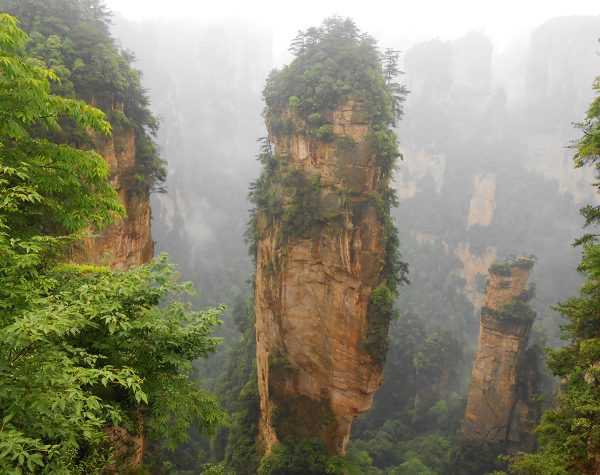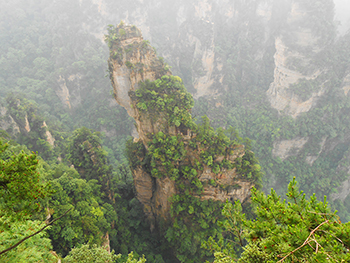
The landscape of the Zhangjiajie National Forest Park has attracted admiration throughout the world, in part thanks to its inclusion in James Cameron’s cinematic epic Avatar. Yet there’s far more to these incredible mountains than what you may have seen on the silver screen! Before they became cinematic superstars, they served as the inspiration for countless Chinese paintings and have been immortalised in the works of several Chinese masters. While the park’s iconic pillars look similar to the Karst mountains of southern China, they are actually made of quartzite-sandstone and are the result of physical rather than chemical erosion. Over time, expanding ice and plants growing on the cliff-face have caused intense weathering, which has resulted in the strange rock formations that we see today.
The park itself is rather confusingly part of a larger attraction known as the Wulingyuan Scenic Area, which is comprised of four national parks within close proximity that contain these special landforms. Collectively, these four parks were designated as an UNESCO World Heritage Site in 1992. The Zhangjiajie National Forest Park actually predates the Wulingyuan Scenic Area, however, as it was established in 1982 and is recognised as the first national forest park in China. The term “Zhangjiajie” literally translates to mean “Home of the Zhang Family” and refers to a military general called Zhang Liang, who served during the Han Dynasty (206 BC-220 AD) and after whom the prefecture-level city of Zhangjiajie was named in honour of his achievements.
Embedded deep within the subtropical forests of northwestern Hunan province, the Zhangjiajie National Forest Park is home to a dizzying collection of 243 peaks and over 3,000 sandstone pinnacles, which naturally dominate the landscape. When the early morning mist gathers around these colossal columns, it appears as though they are floating in mid-air, which is what inspired the floating Hallelujah Mountains in the film Avatar. In fact, one of these mountains has even been named after its mythical movie counterpart!
The 1,080-metre (3,540 ft.) high Southern Sky Column was official renamed the “Avatar Hallelujah Mountain” in 2010. This is indeed a case of art imitating life, and then life imitating art! The Avatar Hallelujah Mountain can be found in a section of the park known as Yuanjiajie, which offers breath-taking panoramic views of the surrounding mountains and thus ranks as the most popular part of the park. In order to reach Yuanjiajie, visitors can either hike to the top, which takes about 2 hours, or they can take the spectacular Bailong Elevator, which takes around 2 minutes. Be forewarned, however, that the line for the Bailong Elevator can be up to 2 hours long, meaning you won’t necessarily save time!

Rising to a staggering height of 326 metres (1,070 ft.), the Bailong or “Hundred Dragon” Elevator is the tallest outdoor elevator in the world and is actually made up of three separate glass elevators, which can each carry 50 people at a time. To put that into perspective, this set of glass elevators can transport over 2,000 people to the peak of the mountain every hour! These elevators aren’t for the faint of heart, as they are covered almost entirely in transparent class and offer a dizzying view of the ascent to the top of Yuanjiajie.
Alongside the Bailong Elevator and the Avatar Hallelujah Mountain, Yuanjiajie’s final claim to fame is known as the First Bridge Under Heaven. This unusual bridge is unlike any other in the world, as it has been formed by the natural weathering of the rock. With a length of around 20 metres (66 ft.) and a width of roughly 3 metres (10 ft.), this spectacular stone bridge connects two separate peaks and sits at a dizzying height of nearly 400 metres (1,312 ft.). Once you see how high up it is, however, you may find that crossing it is a bridge too far!
Once you’ve finished climbing to impossible heights, you can take a leisurely stroll along Golden Whip Stream, which is a brook that can be found at the base of the mountains. The stream is just over 7 kilometres (4 mi) in length and makes for a pleasant 2-hour hike, during which time you can marvel at the towering pinnacles that surround you. While seeing the panoramic view from the top of Yuanjiajie will undoubtedly take your breath away, the view from the bottom of the mountains is certainly no less magnificent. Be forewarned, however, that the area around the stream is inhabited by wild macaques, so be sure not to monkey around or you might attract some unwanted attention!